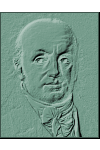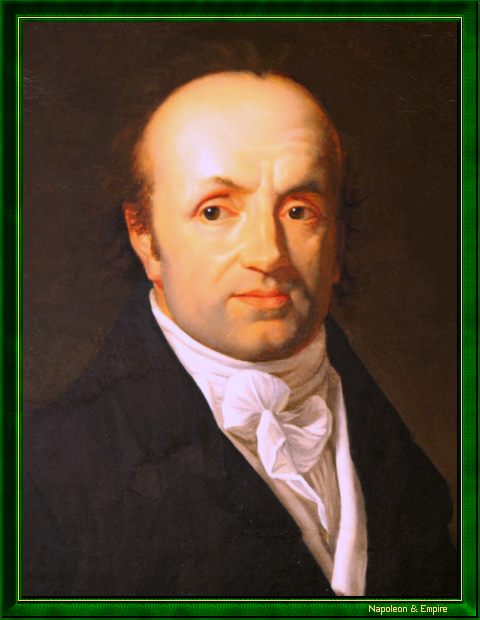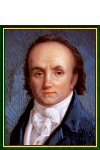Abraham-Louis Breguet
Pronunciation:

Abraham-Louis Breguet was born on January 10, 1747 in Neuchâtel, then under the sovereignty of the King of Prussia.
He trained as a watchmaker first in Les Verrières, near his birthplace, then for a decade in Versailles (in particular with Ferdinand Berthoud, watchmaker to the Royal Navy, and Jean-Antoine Lépine). In 1775, he moved to Paris and opened his own workshop at 39 quai de l'Horloge on the Île de la Cité.
As early as 1780, he invented the so-called perpetual or automatic watch, featuring a rotor which, via a reduction gear, winds the watch's spring to the wearer's slightest movement. The Duc d'Orléans was the first purchaser of such a model, and in 1782, Queen Marie-Antoinette commissioned him to produce the n°2 10/82 perpetual repeater and date watch.
In 1783, he invented the spring-timbre for repeater watches, and the following year was officially recognized as a Master Watchmaker.
It was during this period that he established the aesthetics that would henceforth characterize the brand: so-called apple hands, Arabic numerals and a guilloché dial.
The years of revolutionary turmoil saw Abraham-Louis Breguet multiply his inventions and innovations, first in Switzerland, where he lived for three years on the advice of Jean-Paul Marat, then in Paris: ratchet key and oil-free natural escapement in 1789, Pare-chute anti-shock device in 1790, mechanism for Claude Chappe's optical telegraph in 1792, first description of the sympathetic pendulum, development of the perpetual calendar, the Breguet Spiral and the ruby cylinder in 1795, simple single-hand watch known as the Montre de Souscription in 1796 (for which the customer must pay an advance when ordering), patent for the constant-force escapement and invention of the musical chronometer in 1798, creation of the tact watch in 1799.
Under the Consulate and Empire, his main invention was the tourbillon regulator in 1801, which he did not make public until five years later. He definitively established the primacy of the Breguet brand by having as customers all members of the Bonaparte family, starting with Napoleon himself, who had acquired three timepieces before the Egyptian expedition in 1798: a repeating watch with isolated escapement, a travel clock with almanac and repeater, and a perpetual repeating watch.
The same goes for the two empresses, Josephine and Marie-Louise, and the Emperor's siblings (the best customer being Caroline Murat, recipient of no less than thirty-four watches and clocks between 1805 and 1814, including the first wristwatch in history, ordered in 1810 and completed at the end of 1812). Not surprisingly, Breguet's customers also included marshals, high dignitaries and ministers.
In 1814, Abraham-Louis Breguet became a member of the Bureau des Longitudes.
During the Restoration, he was appointed watchmaker to the Royal Navy in 1815, joined the Académie des Sciences and was awarded the Légion d'Honneur by King Louis XVIII.
These honors did not diminish his talent for innovation, quite the contrary: double barrel marine chronometer in 1815, astronomical telescope eyepiece in 1819, double seconds watch or observation chronometer - ancestor of the modern chronograph - in 1820.
Abraham-Louis Breguet died in Paris on September 17, 1823, leaving a flourishing company in the hands of his son Antoine-Louis (who had joined the company in 1807). He is buried in the Père-Lachaise cemetery (11th division) .
"Abraham-Louis Breguet". French school from the beginning of the 19th century.

To understand just how far ahead of his time this genius watchmaker was, we need only compare the year in which the wristwatch was created for Caroline (1810-1812) with the year in which this accessory began to appear with other watchmakers: 1868 with Patek-Philippe (for the Hungarian Countess Kocewicz), then around 1880 for more general distribution (first adopted by ladies, then at the turn of the century by men).
Abraham-Louis Breguet was never a Swiss citizen. The canton of Neuchâtel did not join the Swiss Confederation until 1814; however, Breguet, born a subject of the King of Prussia, acquired French nationality in 1792, which he retained until his death.
Four years after his death, in 1827, his son completed the famous watch including all known complications, named Marie-Antoinette, which Abraham-Louis Bréguet had undertaken to produce.
Other portraits
